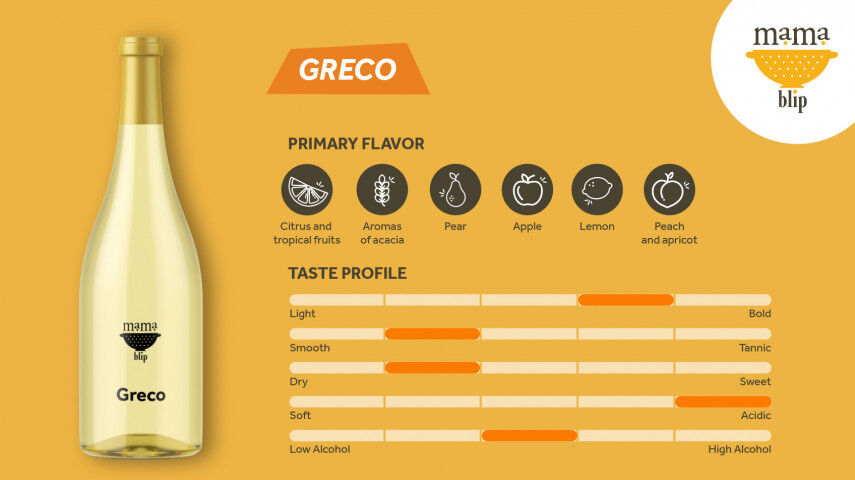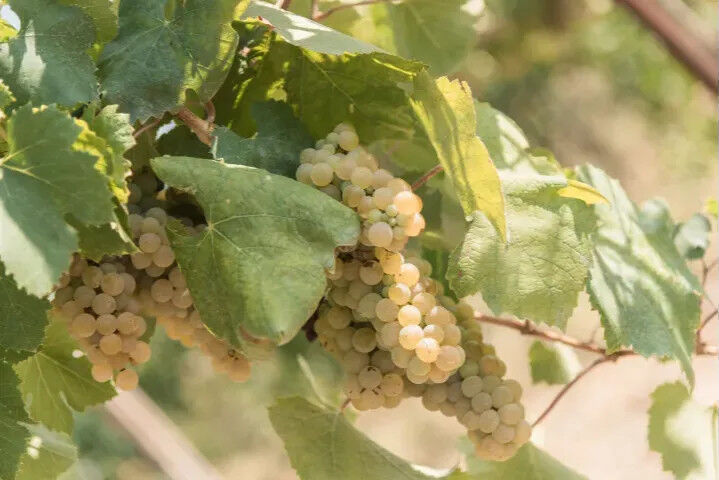Greco (di Tufo) Wines ( grapes) in 30 seconds
- Greco is an umbrella name for around a dozen varieties including a handful of black grapes.
- The most famous wine is the deep yellow Greco di Tufo DOCG from Campania.
- Another well-known wine is Greco di Bianco is a Calabrian mutation of Malvasia di Lipari responsible for the Greco di Bianco DOC.
- This grape is mostly cultivated in Campania where some of the best come from Irpinia.
- It also grows in Calabria and Puglia.
- Greco is a late ripener.
- White wines range from youthful, fresh, and herbal styles to stone-fruit-rich, oily, and full-bodied with aging potential.
- There’s also a spumante style of Greco di Tufo.
- Greco is quite tannic by white wine standards.
- The abv level for Greco di Tufo is around 11.5% to 13%.
What is Greco wine?
Greco is a family of cultivars that produce predominantly white wines in a range of styles in the southern Italian regions of Campania and Calabria. It’s best known for the wine Greco di Tufo.
Learn about Greco
The white Greco varietal hails from the area around the town of Tufo. Its most renowned appellation is Greco di Tufo DOCG, a fine wine enriched by the unique sulfur, clay, and volcanic soils of the local terroir. The DOCG is one of four in Campania, the highest number in any southern Italian wine region.
While the Greco grape is a different variety to Calabrian Greco di Bianco, they’re sometimes confused in wine circles. To add to the mix, other southern Italian grapes with no connection to either, have "Greco" or "Greco Bianco" in their names.
Greco is not to be confused with “Grechetto”, a different grape entirely but with a similar name!
What does Greco taste like?
- Youthful dry Greco typically displays apricot, blossom, green apple, creamy, earthy full body, and a gently tannic finish. Rich minerality is also a feature of this wine.
- Greco is usually best enjoyed young but it has the components to age well. Mature Greco has honey, pear, tropical and stone fruit, nutty notes, and florals.
- Spumante Greco is fresh and acidic with fruit and a light brioche note.
What type of wine is Greco?
Greco is made in a dry youthful style as well as a mature expression. It’s also vinified into a spumante wine.
What do you eat with Greco di Tufo?
With its fruit, body, and structure, Greco is a versatile wine for food pairing. When pairing this grape with food, keep in mind its age and bubbles (or lack of them). Below are some ideas for youthful, mature, and spumante Greco di Tufo.
Youthful Greco Food Pairing
- Appetizers: Charcuterie; green olives; calamari; mussels.
- Entrées: Seafood salad; chicken salad; caper and tomato sauces on fish or pasta; tomato-rich pizzas.
- Cheese: Mozzarella; Burrata; Ricotta.
Mature Greco do Tufo
- Appetizers: Prosciutto di Parma; black olives; sardines; bruschetta.
- Entrées: Roast chicken; seafood; seafood risotto; grilled fish; spaghetti alla puttanesca; lasagne alla parmigiana.
- Cheese: Mozzarella; Burrata; Ricotta.
Spumante Greco di Tufo
This wine is the perfect aperitif and also goes well with charcuterie, sushi, mixed olives, calamari, lightly fried dishes, seafood cuisine, and bruschetta.
Where is Greco di Tufo?
In addition to Greco di Tufo DOCG, the leading appellations for Greco include Bianco di Pitigliano, Capri, Gravina, Greco di Bianco, Irpinia, Lamezia, Melissa, Penisola Sorrentina, Roma, and, Vignanello.
These are all DOCs.
Where does Greco di Tufo come from?
Greco may be the descendant of ancient Greek settlers who brought their vines and winemaking skills with them to what’s now southern Italy, nearly three millennia ago. However, DNA profiling has not determined this definitively. The name of the grape could also be after the old style of sweet winemaking developed by the Greeks.
Italian winemakers have suggested Greco may have been a blending grape in the cult wines of ancient Rome, Falernian, and Aminean.
Greco, along with many southern Italian varieties, nearly went extinct after World War Two in the wake of devastation in the area and high migration to other parts of Italy and abroad. Special projects dedicated to grapes important to Italian wine heritage saved grapes like Greco.
Early this century, DNA research revealed that some Greco plantings share genetic information with the Campania grape Asprinio. However, some Italian wine experts have challenged this claiming the aroma and flavor profiles of both grapes are too different.
Today, Greco mostly grows in southern Italy but there are also small plantings in Australia and Portugal.
How is Greco made?
Greco di Tufo received its DOCG status in 2003. Appellation regulations stipulate that the wine must contain a minimum of 85% of the Greco grape. The remaining 15% is made up of approved local varieties.
With youthful Greco di Tufo, winemakers focus on the fruit. This means they’ll use inert vessels like stainless steel and avoid processes like malolactic fermentation. There may be a few months in bottle before release.
Mature expressions are also fruit-forward but may undergo steps like lees aging to add body and texture and longer bottle maturation.
Spumante is made with the traditional method, the prestigious process behind Champagne production. This means the wine has a second fermentation in bottle. It has to age for at least three years.
What kind of wine is similar to Greco?
Fun facts
- In spite of its name, Greco’s connections to ancient Greece are speculative.
- Synonyms include Greco del Vesuvio, Greco della Torre, and Greco di Napoli.
- The grape is sometimes called Greco di Tufo but this is one of the wines it makes and not the varietal.





